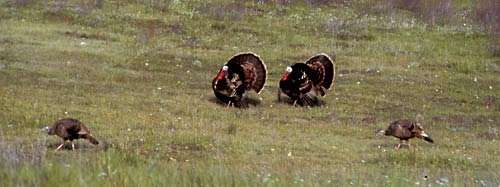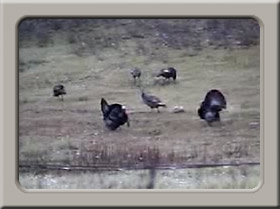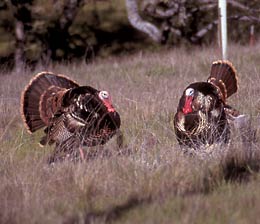UC Berkeley Press Release
 A dominant male wild turkey (left) and his subordinate brother display their tail fans and bright heads and throats to attract so-far uninterested females at UC Berkeley's Hastings Natural History Reserve in Carmel Valley, Calif. (Photo by Alan Krakauer/UC Berkeley) |
In the mating game, male wild turkeys benefit even when they don't get the girl
BERKELEY – For wild turkeys, at least, helping your brother find a willing and eager mate is a better way to pass on your genes than chancing the mating game alone, according to a new study by a University of California, Berkeley, graduate student.
 |
Cooperative courtship In this downloadable video, a coalition of males displays in front of a group of females before the subordinate male rushes off to chase away young male rivals. Video by Alan H. Krakauer |
"This study not only shows that the males are related, but that the indirect gain in fitness through your relative's gain is equal to or greater than the expense of cooperating," said the study's author, Alan Krakauer. "This is one of the best demonstrations in vertebrates that the benefits of cooperating can outweigh the costs because of kinship alone."
Krakauer, a Ph.D. student in UC Berkeley's Department of Integrative Biology and the Museum of Vertebrate Zoology, published his results in the March 3 issue of Nature.
The cooperative courtship of brother turkeys is one case of the general evolutionary principle of kin selection, which posits that individuals may engage in altruism - behavior detrimental to their survival or reproduction - if the behavior increases the survival or reproductive output of their relatives. Such behavior can include caring for a relative's young or sending out alarm calls to warn nearby relatives at the peril of drawing the attention of a predator.
"Although kin selection is widely invoked as an explanation for cooperation, obtaining the fitness data necessary to demonstrate kin selection can be really tough," said Eileen Lacey, UC Berkeley associate professor of integrative biology and one of Krakauer's advisors. "Wild turkeys, in particular, have been purported to be an example of kin selection, and now Alan has tested this hypothesis and shown that they are. He is filling in an important missing piece of the puzzle."
Kin selection was first proposed by biologist W. D. Hamilton in 1964 to explain cooperation, which goes against the idea that natural selection or survival of the fittest favors selfish behavior. He hypothesized that kin selection increases the "inclusive fitness" of an individual. Inclusive fitness takes account of an individual's own offspring as well as a portion of the extra offspring that relatives are able to produce because of the individual's help. Thus, kin selection can favor cooperation even if it means losing some or all of your own reproduction. In other words, Hamilton conceived that individuals can benefit indirectly by helping a relative.
For example, in the wild turkey population that Krakauer studied at UC Berkeley's Hastings Natural History Reserve in Carmel Valley, Calif., male turkeys typically paired up to follow groups of females and display in front of them. Both males would blush brilliant red and blue about the face and throat, fan their colorful tails and drop their wings, but only the dominant male would perform the classic strut - shuffling his feet and emitting a low drumming noise.
"While the dominant male was strutting, however, the subordinate might continue to display, like a back-up singer, or even chase away other males that got too close," Krakauer said.
In order to establish which male actually copulated with the female - an activity hard to see in the brush - Krakauer captured, tagged and obtained blood samples from male and female turkeys, and then captured flightless young, scavenged broken egg shells from abandoned nests or lifted eggs from unattended nests to obtain the DNA of offspring. His study included 126 adult turkeys - 51 males and 75 females - and 325 offspring between 1999 and 2004, though only eight of his marked, resident males fathered young.
 Two male wild turkeys form a coalition to display and attract females, though only the dominant male will breed. (Photo by Maria Soares/UC Berkeley) |
Krakauer noted that subordinate males probably could have had some breeding success on their own. But this solitary breeding would not offset the advantage of helping a dominant brother. A subordinate male's inclusive fitness - in other words, the net benefit of cooperation - works out to about 1.7 offspring.
"Basically, since subordinate males and dominant males share some proportion of their DNA, the subordinate males benefit indirectly by helping their relative breed," Krakauer said. "A subordinate partner gains more by giving help than it would by going off on its own and trying to breed by itself."
He also looked for other possible benefits to the subordinate males, since in the case of two other birds thought to exemplify kin selection, other benefits were found to outweigh kin selection. In a group of New World tropical birds called manakins, subordinate males were found to help dominant males attract mates because they would eventually inherit the mating territory, which is jealously guarded. And in a Eurasian sandpiper called the ruff, helpers bring in additional females, but when the dominant male is distracted, they are able to sneak copulations, directly passing on their own genes by mating with females.
Krakauer found that neither of these situations held in the California wild turkey population - thought to be descendents of the introduced Rio Grande turkey, Meleagris gallopavo intermedia.
"In this population of wild turkeys, cooperating males don't seem to be sneaking copulations," Krakauer said. "Also, these turkeys aren't territorial, so there is no territory to inherit."
Integrative biology professor Walter Koenig, another of Krakauer's advisors and an expert on mating systems, social behavior and reproductive strategies of birds, was impressed by Krakauer's tenacity in pursuing the turkeys to answer a very fundamental question of evolution.
"Frankly, it surprised the heck out of me that it actually worked. I always expected this textbook example of kin selection not to be true," Koenig said. "Alan's real lasting contribution is that he has actually done the test, demonstrating that it pretty much works out the way those guys envisioned it over 30 years ago."
The work was supported by a National Science Foundation graduate fellowship and Doctoral Dissertation Improvement Grant, in addition to funds from the Animal Behavior Society, the American Ornithologists' Union, Sigma Xi, the Department of Integrative Biology and the Museum of Vertebrate Zoology.

